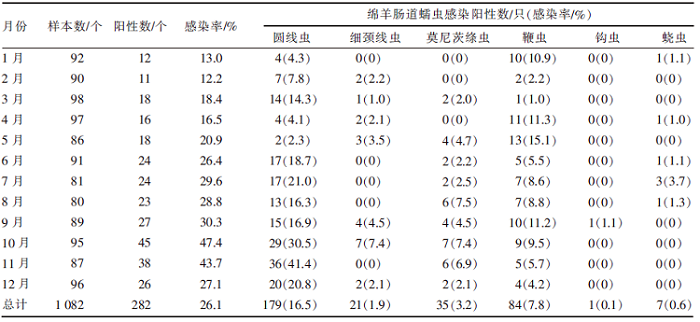| [1] |
李莹莹, 乌翠兰, 李斌, 等. 内蒙古乌审旗地区羊寄生虫感染流行病学调查[J]. 中国兽医杂志, 2017, 53(4):55-57,123.
|
| [2] |
其力木格, 何秀玲, 额尔登巴特尔, 等. 典型草原的轮牧方式对绵羊蠕虫病流行病学的影响[J]. 黑龙江畜牧兽医, 2020(3):70-74.
|
| [3] |
额叶勒德格, 曹增富, 海鹰, 等. 乌审旗地区绵羊消化道线虫感染情况及耐药性的调查[J]. 中国兽医科学, 2018, 48(6):735-742.
|
| [4] |
李国清. 兽医寄生虫学[M]. 2版. 北京: 中国农业大学出版社, 2015:187-204.
|
| [5] |
汪明. 兽医寄生虫学[M]. 3版. 北京: 中国农业出版社, 2003:31-32.
|
| [6] |
那日苏, 苏布登格日勒, 哈斯图雅, 等. 乌审旗地区绵羊主要蠕虫病流行病学调查及驱虫效果比较试验[J]. 内蒙古农业大学学报(自然科学版), 2021, 42(1):1-5.
|
| [7] |
温晴. 泰来、锡林浩特、牙克石绵羊胃肠寄生虫调查及驱虫比较[D]. 哈尔滨: 东北农业大学, 2021.
|
| [8] |
郭利英. 乌兰察布农村地区羊寄生蠕虫种类的调查[J]. 黑龙江畜牧兽医, 2015(24):140-141.
|
| [9] |
马晓野. 通辽地区绵羊感染蠕虫情况调查及驱虫药治疗效果观察[D]. 哈尔滨: 东北农业大学, 2019.
|
| [10] |
郭筱璐, 杨怡, 施宇, 等. 国内羊胃肠道寄生虫流行病学调查及捻转血矛线虫系统进化分析[J]. 中国兽医学报, 2018, 38(7):1332-1337.
|
| [11] |
刘利霞, 徐桂杰, 苏乙拉, 等. 锡林浩特市周边地区绵羊消化道线虫季节动态的调查[J]. 黑龙江畜牧兽医, 2016(16):108-110.
|
| [12] |
姜佳林. 赤峰北部两旗牧区昭乌达肉羊寄生虫流行情况的调查和分析[D]. 呼和浩特: 内蒙古农业大学, 2021.
|
| [13] |
王权, 马更尕, 于天明. 天祝藏族自治县绵羊内寄生虫感染的季节动态调查[J]. 畜牧与兽医, 2013, 45(8):99-103.
|
| [14] |
岳建伟, 冯陈晨, 刘宁, 等. 巴彦淖尔地区舍饲成年肉羊消化道线虫感染的调查[J]. 畜牧与兽医, 2016, 48(4):119-122.
|
| [15] |
BANSAL D K, AGRAWAL V, HAQUE M. A slaughter house study on prevalence of gastrointestinal helminths among small ruminants at Mhow, Indore[J]. Journal of Parasitic Diseases, 2015, 39(4):773-776.
doi: 10.1007/s12639-013-0413-3
pmid: 26688650
|
| [16] |
BIHAQI S J, AllAIE I M, BANDAY M A A, et al. Prevalence of caprine GI helminths in temperate areas of Jammu & Kashmir[J]. Journal of Parasitic Diseases, 2017, 41(3):843-849.
doi: 10.1007/s12639-017-0900-z
|
| [17] |
SINGH E, KAUR P, SINGLA L D, et al. Prevalence of gastrointestinal parasitism in small ruminants in western zone of Punjab, India[J]. Veterinary World, 2017, 10(1):61-66.
doi: 10.14202/vetworld.2017.61-66
pmid: 28246448
|
| [18] |
黄占欣, 米同国, 赵霞, 等. 邯郸地区羊消化道蠕虫感染情况调查[J]. 黑龙江畜牧兽医, 2015(6):67-69.
|
| [19] |
关琛, 刘峡, 任一, 等. 张家口地区羊消化道线虫感染虫种及感染率的调查[J]. 河北北方学院学报(自然科学版), 2018, 34(9):37-40,44.
|
| [20] |
陈思羽. 四川省凉山彝族自治州四县市羊蠕虫感染情况调查[D]. 雅安: 四川农业大学, 2019.
|


